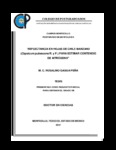Reflectancia en hojas de chile manzano (Capsicum pubescens R y P) para estimar contenido de nitrógeno
Abstract
Con la finalidad de encontrar un procedimiento económico, rápido y confiable que estime el contenido de nitrógeno (N), se estableció un experimento en los invernaderos del Colegio de Postgraduados. La unidad experimental consistió de una planta de chile manzano sembrada en maceta de polietileno negro calibre 600 de 40x45 cm a una distancia de 1.5 m entre hileras y 0.5 m entre macetas. Como sustrato se utilizó tezontle rojo. Se emplearon soluciones nutritivas con cuatro niveles de N: 4, 8, 12 y 16 molc m-3 (en el último tratamiento 2 molc m-3 corresponden a NH4+), a partir de la solución Steiner. El diseño experimental fue completamente al azar con cuatro repeticiones. En plena fructificación, en cada unidad experimental, se seleccionaron seis hojas y se les tomo fotografía digital y se escanearon. Posteriormente, con el programa de computo IDRISI Andes, cada imagen se separó en sus colores primarios (bandas azul, verde y rojo) y se extrajeron las reflectancias correspondientes a las longitudes de onda 450-495, 495-570 y 620–750 nm, respectivamente. En laboratorio se determinó la concentración de N mediante el método microkjeldahl. Las concentraciones de N en las hojas se relacionaron con las reflectancias obtenidas en las bandas azul, verde y roja, de cada método. Se correlacionó la concentración de N y las reflectancias obtenidas en las bandas azul, verde y roja, mediante el programa estadístico Statistical Analysis System (SAS, 2003). La reflectancia en la banda del verde obtenida con escáner de escritorio mostró ser el mejor estimador del contenido de nitrógeno en plantas de chile manzano (R2=0.97). Se obtuvo la regresión entre lecturas SPAD y la concentración de nitrógeno en follaje. Estas variables presentaron un alto coeficiente de ajuste (R2=0.86), pero resulto inferior al obtenido con el escáner. _______________ REFLECTANCE IN LEAVES MANZANO HOT PEPPER (Capsicum pubescens R y P) TO ESTIMATE NITROGEN CONTENT. ABSTRACT: With the objective of finding an economic, rapid and reliable procedure that estimates the concentration of nitrogen, an experiment in the greenhouses of the “Colegio de Postgraduados" was established. The experimental unit consisted of a plant of Capsicum Pubescens R. y P. planted in black polyethylene pots caliber 600 and 40x45 cm at a distance of 1.5 m between rows and 0.5 m between pots. Red tezontle was used as substrate. We utilized four nutrient solutions with different levels of NO3-: 4, 8, 12 and 14 meq L-1, from the Steiner solution. An experimental design was used completely at random with four replications. When plants reached the fruiting stage (seven months after transplant), in each experimental unit, six leaves were selected and scanned to obtain digital images. Later, with the program IDRISI Andes, each image was separated in their primary colors (red, blue, and green bands) and we extracted the reflectances corresponding to wavelengths 450-495, 495 - 570 and 620 - 750 nm, respectively. In the laboratory leaves were processed to determine the concentration of nitrogen through the microkjeldahl method. The concentrations of nitrogen in the leaves were related to the reflectances in blue, green and red bands. We estimated correlations of Pearson of the concentration of nitrogen with the reflectances obtained in the red, green, and blue bands through the statistical programme Statistical Analysis System (SAS, 2003). The reflectance in the green band proved to be the best estimator of the of nitrogen concentration in plants of Capsicum pubescens R. y P. (r = - 0.95).
Collections
- Tesis MC, MT, MP y DC [349]

